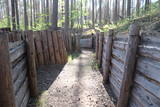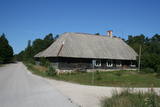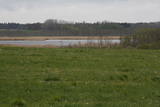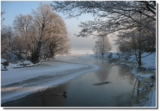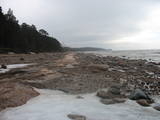| Nr | Nosaukums | Apraksts |
|---|---|---|
|
Dagdā pirmo katoļu draudzes baznīcu no koka 1705. g. uzcēla Viļakas stārasts J. Hilzens. Mūsdienās redzamais dievnams ir tapis 18. gs. otrajā pusē (baroka stils) par grāfa J. A. Holzena līdzekļiem. Ēkas iekšpusē uzmanību vērts pievērst altārim, kancelei, ērģelēm, grāfu Hilzenu dzimtas piemineklim u.c. interjera priekšmetiem. + 371 65653634. Ziemeļos no baznīcas var izstaigāt Dagdas vēsturisko centru, kam raksturīgas 20. gs. sākuma no sarkanajiem ķieģeļiem celtās ēkas – t.s. ebreju tirgotāju nami. |
||
|
Ar Kara muzeja informatīvo atbalstu Garā kāpā pie Antiņiem ir rekonstruēta daļa latviešu strēlnieku nocietinājumu sistēmas. Aspkatāmas ierakumu pozīcijas un vairākas zemnīcas. Netālu atrodas bijusī un no dzelzsbetona veidotā medikamentu glabātuve. |
||
|
Atrodas Skolas ielā 12, Priekules pamatskolā. Tās krājumā ir plašs Priekules novadā iegūto vēsturisko liecību klāsts – sadzīves priekšmeti, darbarīki, dokumenti, padomju gados izsūtīto un represēto cilvēku atmiņu stāsti u.c. liecības, kā arī Priekules skolu attīstības vēsture. |
||
|
Elkas kalna saimniecība atrodas ainaviskā Elkas kalna virsotnē. Saimniecībā tiek audzētas zāļu tējas, izgatavoti ziedūdeņi no Elkas kalna pļavās ievāktiem un dārzā audzētiem augiem, tecinātas bērzu sulas, kuras saldētas glabājas līdz pat vasarai, gatavoti ievārījumi un citi veselīgi gardumi. Amatas pagasta stāstnieku pavadībā iespēja doties ekskursijā-pārgājienā uz Gaujas sākumu Elkas kalnā vai augu ekspedīcijā, kuras laikā saimniece iepazīstina apmeklētājus ar dažādām zāļu tējām, palīdz sagatavot savu īpašo tēju maisījumu vai ziepes. Degustācijai - zāļu tēja, bērz sula, ievārījumi, pašu gatavotu ķirbju miltu izstrādājumi. Piedāvājumā no Elkas kalna saimniecībā audzētiem dārzeņiem, dīķī nomakšķerētām zivīm vai gaļas gatavotas maltītes, kuras pagatavojamas arī ārā uz dzīvas uguns. Iespēja nakšņot teltī. Pieejama terase nelielām svinībām. |
||
|
Atpūtas vieta atrodas Dienvidkurzemes vēsturiskajā Papes Ķoņu ciemā. Naktsmītne – klēts, vēsturiska ēka ar niedru jumtu, pielāgota dzīvošanai vēlā pavasarī/vasarā/agrā rudenī. 3 istabiņas + neliela priekštelpa un virtuve divos stāvos. Piemērota 8 cilvēkiem. Ideāla vieta radošām nometnēm, plenēriem, meistardarbnīcām un citām aktivitātēm. Telšu vietas, kur var uzņemt līdz 80 cilvēkiem. Mikjāņu sēta sadarbībā ar Rucavas tradīciju klubu interesentu grupām piedāvā iespēju baudīt vietējos tradicionālos ēdienus iepriekš vienojoties - „siļķi uz ogles”, balto sviestu ar vārītu kartupeli, riezu, zivju zupu, u.c Piedāvājums pieejams tikai grupām, iepriekš piesakoties. |
||
|
Meklējama starp Pīlādžu ielu un Siliņupes kreiso krastu. III – II g.t. pr. Kr. šeit atradās zvejnieku un mednieku apmetne, kuras vietā uzstādīts informējošs piemiņas akmens (tēln. O. Skarainis). Siliņupes apmetne ir senākā zināmā cilvēka apdzīvotā vieta Ķemeru nacionālā parka teritorijā. Šeit atrastas daudzas senlietas: māla trauku lauskas, bultu uzgaļi, krama un dzintara gabaliņi u.c. Iespējams, ka blakus esošo privātmāju teritorijā ir atradies apmetnes kapulauks. Neliela daļa no atradumiem apskatāma Lapmežciema muzejā, pārējie atrodas Latvijas Nacionālajā vēstures muzejā. |
||
|
Krodziņš "Vilhelmīnes dzirnavas" atrodas Līgatnes vēsturiskajā centrā pie dīķa - vienā no vecākajām ēkām Līgatnē ,kurā tika pagatavots pirmais Līgatnes papīrs, tad bijušas dzirnavas un no tiem laikiem pie krodziņa ieejas var redzēt tās dzirnakmeni. |
||
|
Bērzciema Lagūna ir atpūtas vieta zvejnieku ciematā Bērzciemā. Tiek piedāvātas divas teltis, katra ir 28 kvadrātmetrus liela, ar visām nepieciešamajām ērtībām, tostarp divguļamo gultu un atpūtas zonu. Viesu rīcībā ir arī pašapkalpošanās virtuve, āra duša un piknika vietas. Pēc iepriekšējas vienošanās vienā teltī maksimāli var izmitināt 4 personas. Piedāvājumā ir arī velosipēdu un SUP noma, telšu vietas un peldvieta jūrā. Glempings atrodas Enguras ezera Dabas parkā, kurā ir vairākas dabas takas, kā arī Engures ezera dabas taka ar savvaļas dzīvniekiem un putnu novērošanas torni un orhideju taka.
|
||
|
Atrodas Kuršu laukuma malā, E. Veidenbauma ielā 1. Pilsētas vecākā baznīca, par kuru saglabājušās ziņas no 1508. gada. Pirmais dievnams šajā vietā bija celts no koka. Pēc vairākkārtējām pārbūvēm (pēdējā - 1893. g. Liepājas arhitekta Paula Marksa Berči vadībā), tas ieguvis tagadējo neogotiskā stila veidolu ar gandrīz 60 m augstu torni. Baznīcas iekārta ir slavena ar vienu no izcilākajiem Latvijas baroka laika meistardarbiem (kokgriezējs Nikolass Sēfrenss jaunākais) - altāri, kam 2012. g. atzīmēja 350 gadskārtu. Altāri uzskata par vienu no izcilākajiem tā laika Austrumeiropas darbiem. Tā retabls (5,8 x 9,7 m) ir pazīstams ar Kristus ciešanu tematisko ciklu. Dievnamā atrodas trešās lielākās Latvijas ērģeles, kas darinātas pēc komponista un ērģelnieka Alfrēda Kalniņa skices. Baznīcu var apskatīt no iekšpuses un uzkāpt tās tornī. |
||
|
Teearu saimniecībā gatavo dažādus ēdienus no Peipusa ezera zivīm, īpaši iecienīts ir šeit gatavotais marinētais, kūpinātais breksis. Iespējams nobaudīt arī pēc tradicionālām metodēm kūpinātu gaļu. Var pasūtīt arī ēdināšanas pakalpojumus. |
||
|
19. gs. 50 gados šeit darbojusies no Žocenes pārceltā skola. Atrodas pie Ģipkas baznīcas. 1938. g. Dundagas korporatīvs te ierīkojis tirgotavu ar pirmās nepieciešamības precēm. |
||
|
Viens no skaistākajiem Latvijas ābeļdārziem (~ 10 ha un 30 ābolu šķirnes), kas iekārtots iespaidīga paugura nogāzēs, no kura augšdaļas skaidrā laikā var redzēt Rīgas jūras līča ūdeņus. Īpaši skaisti šeit ir ziedošu ābeļu laikā. Piedāvā ābolus un degustācijas. |
||
|
Dabas lieguma teritorija ieskauj nelielo Tāšu ezeru un tam pieguļošos ar krūmiem apaugušos purvainos krastus šaurā joslā. Teritorija veidota šeit esošo reto ligzdojošo un migrējošo putnu aizsardzībai. Dabas lieguma teritoriju var lieliski pārskatīt no nelielajiem grants ceļiem, kas to apjož no visām pusēm un atrodas ārpus aizsargājamās teritorijas. Dienvidos no Tāšu ezera atrodas Tāšu muižas komplekss. |
||
|
Mazskarts Salacas upes ielejas posms ar lielu smilšakmens iežu atsegumu, netraucētu alu u.c. biotopu, sugu un ainavu daudzveidību. Salaca ir viena no nozīmīgākajām Baltijas jūras lašupēm un otra populārākā Vidzemes ūdenstūristu upe. Kā galvenie apmeklētāju piesaistes objekti jāmin ģeoloģiskie pieminekļi - Sarkanās klintis, Skaņais kalns, Neļķu klints, Velna ala un kultūras pieminekļi - Lībiešu pilskalns, Vecsalacas muiža, Lībiešu muzejs, Valtenberģu muiža, unikālie Salacas nēģu tači u.c. Parkā atrodas viens no Ziemeļvidzemes populārākajiem tūrisma objektiem – Skaņākalna parks, kurā izveidots blīvs taku tīkls. Salaca ir arī populārs makšķernieku galamērķis. Ietilpst Ziemeļvidzemes biosfēras rezervāta teritorijā. |
||
|
Kalētu muižas bijušais medību dārzs. Muižas laikos šeit ierobežotās platībās turēja meža dzīvniekus, kuru medības bija populārs muižniecības izklaides veids. Parkā uzmeklējams piemiņas akmens Krievijas imperatoram Aleksandram III, kurš šeit nošāvis briedi (irsi). No Kalētiem Latvijas teritorijā „ienāca” staltbrieži, kurus medību vajadzībām 1848. g. atveda no Vācijas. Parkā izveidotas takas un atpūtas vietas. |
||
|
Klinšu smilšakmens ieži veidojušies, ūdens straumēm sanesot smilšainas, mālainas iežu daļiņas. Tās lēnām nogulsnējās un sablīvējās, topot par vareniem dabas veidojumiem! Līgatnes pagrabu alas savām rokām radījuši senie iedzīvotāji. Šī neparastā vieta ļāvusi daudzām paaudzēm izdzīvot, jo alās bija iespēja uzglabāt nepieciešamās pārtikas rezerves. Alām ir nemainīga temperatūra, kas padara tās par drošu pārtikas produktu un dzērienu glabātuvi. |
||
|
Mākslīgi rakts Kaņiera
savienojums ar Rīgas jūras līci, kur ezera
līmeni mūsdienās regulē ar atjaunoto slūžu
sistēmas palīdzību. Laba putnu vērošanas
vieta pavasara un rudens migrāciju laikā.
Orientieris no jūras puses – Starpiņupītes
ieteka jūrā.
|
||
|
Celta 18. gs. beigās agrīnā klasicisma stilā kā grāfu Mellīnu dzimtas īpašums. Mākslinieciski vērtīgi K. V. Kalopkas zāles dekorējumi (1792. g.) un krāsnis (19. gs. beigas). Parks. |
||
|
„Selga uz rietumiem no Tūjas” – nozīmīga teritorija mazā ķīra aizsardzībai pavasara migrācijas laikā. Teritorija atrodas iepretim Salacgrīvas, Limbažu, Saulkrastu un Carnikavas novadam, tās platība ir 58 600 ha.
|
||
|
Atrodas Piņķu centrā, Rīgas ielas malā. Veltīts 1919. gada notikumiem, kad 22. maijā pēc gandrīz divu mēnešu dīkstāves, pulkveža Baloža brigāde devās uzbrukumā Rīgai, lai atbrīvotu galvaspilsētu no lieliniekiem. Baložu brigādei atbalsts bija jāsniedz vācu landesvēram un Vācijas dzelzs divīzijai, kā arī krievu kņaza Līvena nodaļai. Pirmo pieminekli atklāja Latvijas Valsts prezidents Kārlis Ulmanis 1939. gada 23. maijā. 1951. gadā padomju vara to nopostīja, bet 2003. gadā tika uzstādīta pieminekļa kopija (tēlnieks J. Briedis, O. Skaraiņa kopija). |
||

